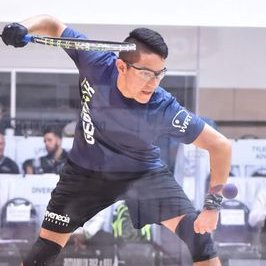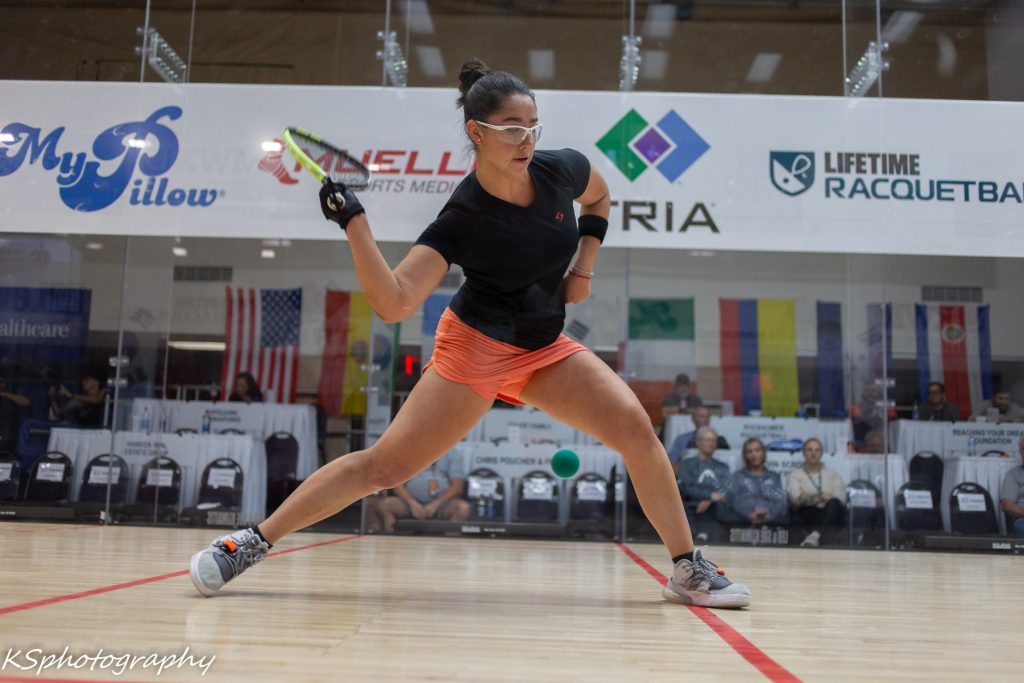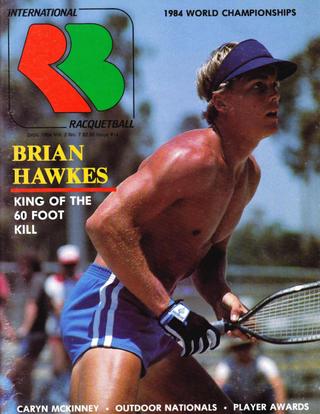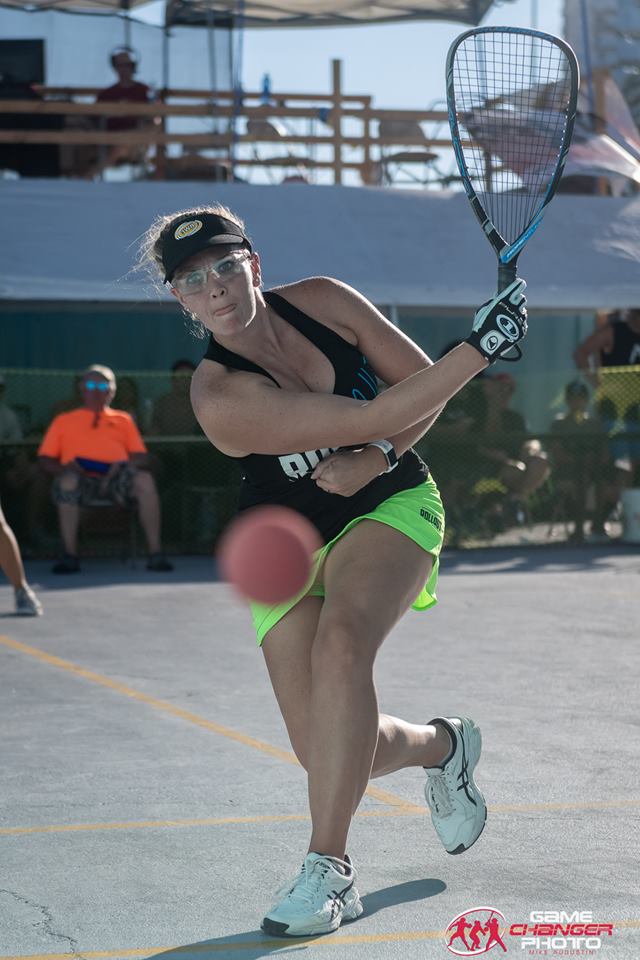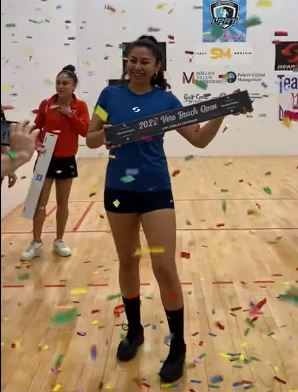
I thought it would be illuminating to break down the LPRT final between Paola Longoria and Alexandra Herrera, looking for some trends and interesting data points.
Using my standard detailed Match Tracker, I filled in match stats for the first game of the final, a nail-biting 15-14 win for Herrera.
Here’s a link to the match tracker detailed data: https://docs.google.com/spreadsheets/d/1t8GgzPppq4dZvZwkS3yITkZAlKGSRQAGROM6woq-0G4/edit?usp=sharing and here’s a link to the video on Facebook for the match: https://www.facebook.com/watch/live/?ref=watch_permalink&v=372683864314937
Here’s some breakdowns.
| Duration Stats | |
| Game start in Video | 6:45 in video |
| Game end | 43:23 in video |
| Game duration | 36mins 38 seconds |
| Avg time per rally | 36.6 secs |
So, this was a long game. 36 minutes overall. Both players took both their time-outs, both players took a brief equipment time-out, and there were a couple of appeals. All told, including the time-outs the average time per rally was 36.6 seconds. This is slightly longer than the average rally time for the last match I did this for; the Parrilla-Waselenchuk Atlanta final tie-breaker.
Serving Breakdown:
| Serving | # of svc attempts | # of Aces | Serves Good | 1st Serve % | 1st Drive Serves | 1st Drive serve % | 1st Lob Serves | 1st Lob Serve % |
| AH Serves | 30 | 2 | 22 of 30 | 73.33% | 30 of 30 | 100% | 0 of 30 | 0% |
| PL Serves | 30 | 3 | 25 of 30 | 83.33% | 30 of 30 | 100% | 0 of 30 | 0% |
Both players served exactly 30 times. Both players drove serve on every first serve, and Paola actually ended up with a higher first serve percentage than Alexandra on the day.
| Serve Selection | % 1st to F | % 1st to B | % 2nd to F | % 2nd to B |
| AH | 33.33% | 66.67% | 25.00% | 75.00% |
| PL | 53.33% | 46.67% | 0.00% | 100.00% |
Paola basically split her drives between Alexandra’s forehand and backhand on the day, hitting 16 drives to the left side, 14 to the right. Meanwhile, as a lefty Herrera has grown up accustomed to primarily serving to right handers, and thus focused mostly on hitting drives to Paola’s backhand. Both hit mostly simple lobs to the backhand as 2nd serves; there was almost no variation on the lob serves used: no nick lob attempt, no wall paper; just half-height lobs meant to solicit a ceiling ball in return.
Serve Breakdown and Success rates
| Serve Type Selection | Serve selection | how often used | Pct Used | How often point? | Pct points |
| AH #1 1st Serve Selection | Drive to Backhand | 19 of 30 | 63.33% | 10 of 16 | 62.50% |
| AH #2 1st Serve Selection | Drive to Forehand | 10 of 30 | 33.33% | 4 of 5 | 80.00% |
| AH #3 1st Serve selection | Hard Z-Serve to Backhand | 1 of 30 | 3.33% | 0 of 1 | 0.00% |
| AH Most frequent 2nd serve selection | Lob Serve to Backhand | 6 of 8 | 75.00% | 1 of 6 | 16.67% |
Here’s where we get some interesting information. Alexandra hit 19 of her 30 serves as drives to the backhand, and got points on 10 of the 16 successful first serves she made. That’s a 62% rate, pretty good. Furthermore, she tried 10 drives to Paola’s forehand, missed half of them, but got points on 4 of the 5 successful serves. She only varied away from these two straightforward serves once; a z-ball to Paola’s backhand that did not work.
| Serve Type Selection | Serve selection | how often used | Pct Used | How often point? | Pct points |
| PL #1 1st Serve Selection | Drive to Forehand | 16 of 30 | 53.33% | 9 of 12 | 75.00% |
| PL #2 1st Serve Selection | Hard Z-Serve to Backhand | 9 of 30 | 30.00% | 3 of 9 | 33.33% |
| PL #3 1st Serve selection | Drive to Backhand | 5 of 30 | 16.67% | 1 of 4 | 25.00% |
| PL Most frequent 2nd serve selection | Lob Serve to Backhand | 5 of 5 | 100.00% | 1 of 5 | 20.00% |
Meanwhile, Paola had a ton of success when driving to Alexandra’s forehand, getting 9 of her 14 points that way and having a huge success rate when she got that serve in. It was clear during the match that she started with the hard-Z to the backhand with little success, then got some points on the forehand drive, and the stuck with it the rest of the way.
| Serves leading to points | pct | |
| AH 1st Serve good | 14 points out of 22 | 63.64% |
| AH 1st Serve bad | 1 point out of 8 | 12.50% |
| PL 1st Serve good | 13 points out of 25 | 52.00% |
| PL 1st Serve bad | 1 point out of 5 | 20.00% |
This chart basically shows why you need to get your first serves in. The two players combined to score exactly 2 points on their second serves all game.
| Rallies | Rallies Won | Pct of Rallies |
| AH Rallies won | 31 of 60 | 51.67% |
| PL Rallies won | 29 of 60 | 48.33% |
| Replays | 0 of 60 | 0.00% |
This shows just how even the match was: out of 60 rallies, they nearly split them 50/50. Alexandra won two more rallies than Paola b/c Paola served first and then Alexandra scored the last point. There was not a single replay in the entire first game.
| Rally Winner/Error Stats | |||||
| (not including serves) | Ttl | FH | BH | Pass | Pinch |
| AH Rally Winners | 20 | 13 | 7 | 11 | 9 |
| AH Rally ending Errors | 3 | 2 | 1 | ||
| PL Rally Winners | 22 | 11 | 11 | 18 | 4 |
| PL Rally Ending Errors | 9 | 7 | 2 |
So, this shows some interesting information. Alexandra hit 13 of her 20 winners on the forehand, and pretty evenly split all her winners between passes and pinches. Meanwhile, Paola really does not shoot for the corners, getting 18 of her 22 winners as passing/kill shots. Paola also shows
The story of this game though is right here: 9 errors for Longoria versus 3 for Herrera. And of those three errors, one was an “off the back wall’ attempt that fell short and a second was a ball that bounced weird off the back wall and jammed her. In other words, Alexandra had just one skip this entire game. Longoria had 9 skips, 7 on her forehand.
| Ratio of Winners to Errors | Ratio | Ratio |
| AH | 20 to 3 | 6.6 winners for every error |
| PL | 22 to 9 | 2.44 winners for every error |
Further illumination of the shotmaking in this game: 20 winners to 3 errors for Herrera.
| (these figures not including serve) | Rally Stats |
| Average # of shots per rally , entire game | 3.95 |
| Average # shots in AH-won rallys | 4.25 |
| Average # of shots in PL-won rallys: | 3.62 |
| Average # of shots in replay rallies | n/a |
| longest Rally of game | 17 and 16: both ended with PL error |
The average number of shots per rally (not including the serve) was 3.95 in this game, but much shorter in Paola won rallies. The 3.95 figure compares to the average rally length for the Parrilla-Kane match, which was just 2.24. Women’s rallies tend to be longer.
| Short Rally Stats | total | % of rallies |
| # of Aces | 5 | 8.33% |
| # of 2 shot rallies (serve, return) | 8 | 13.33% |
| # of 3 shot rallies (serve, return, end) | 4 | 6.67% |
A decent percentage of the 60 rallies were “short” rallies: 1,2 or 3 shots including the serve.
| Game points Saved | |
| by AH | 4 |
| by PL | 3 |
The players managed to save seven game points between them; that’s a heck of an accomplishment by both.
Lastly, since Rally scoring has now been introduced by the IRF, I thought i’d show you what this game would have looked like if it was rally scoring:
| (all these times include Tos) | Rally Scoring Stats |
| Game end if rally | 21:46 in video |
| Game duration if rally | 15mins 1 sec |
| Game score at Rally finish | 8-4 for AH |
If playing rally scoring, the game would have been over in 15mins with the score 8-4 for Alexandra. Instead, we got a 36 minute barn-burner that saw Longoria rally from an 11-4 deficit and nearly take the game. What problem exactly are we attempting to solve with rally scoring? Because every time I do this analysis we’d basically neuter an excellent game.


